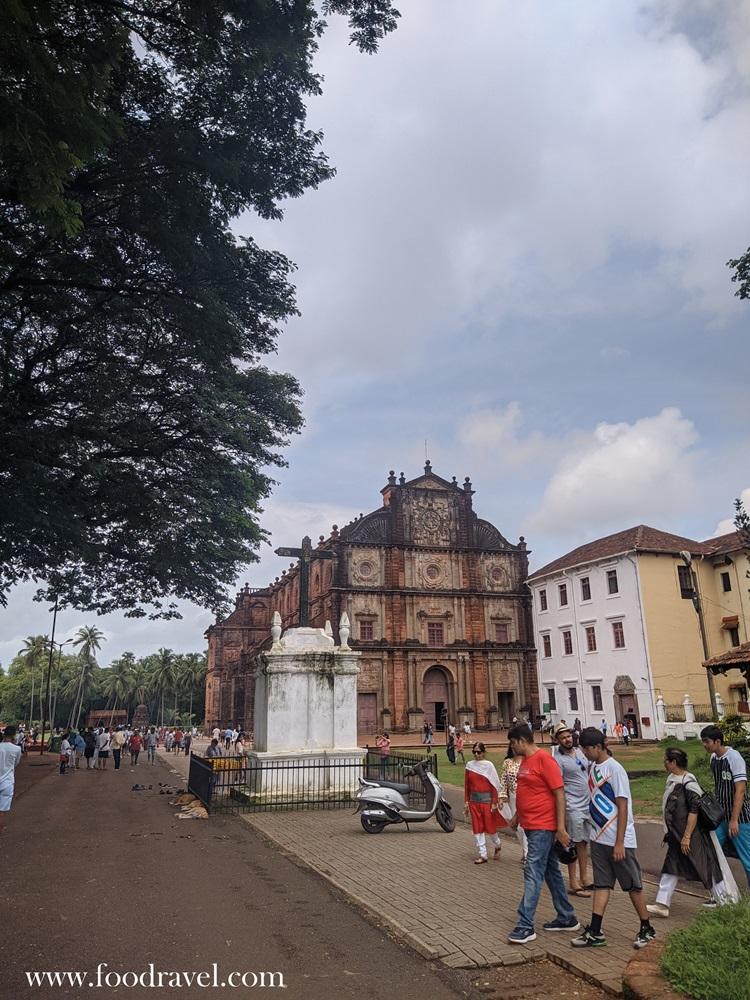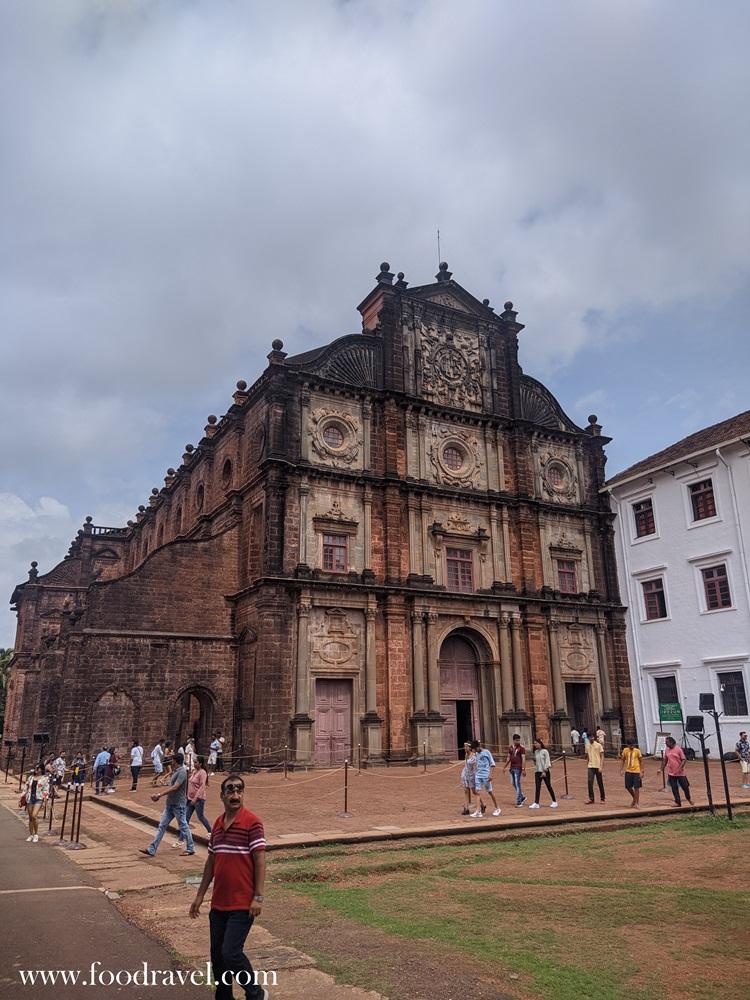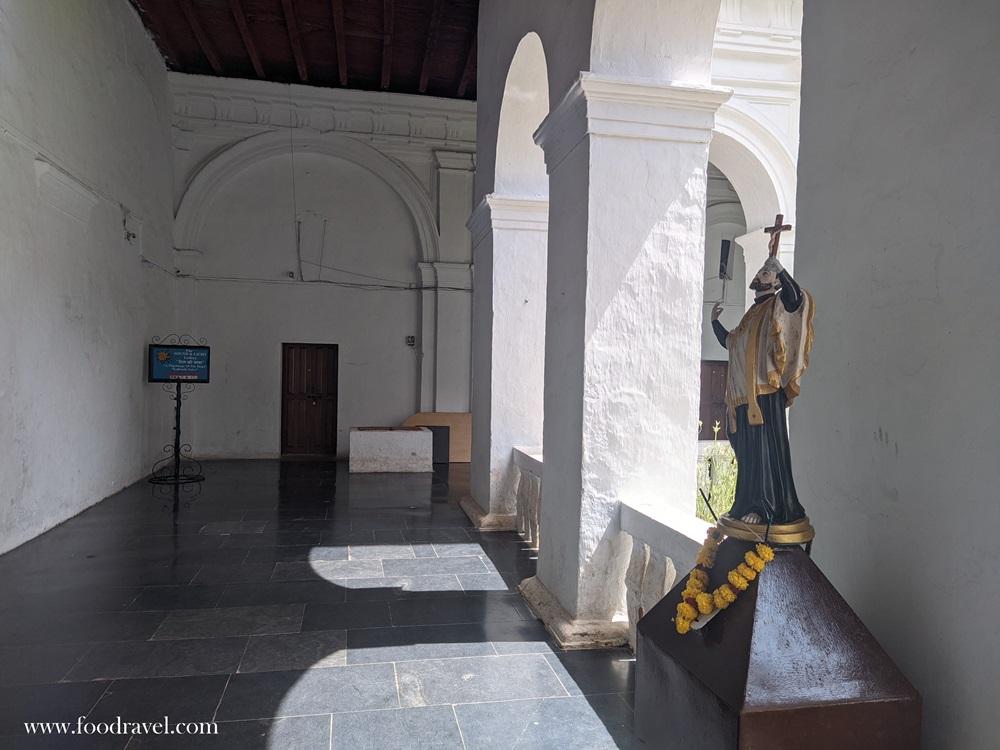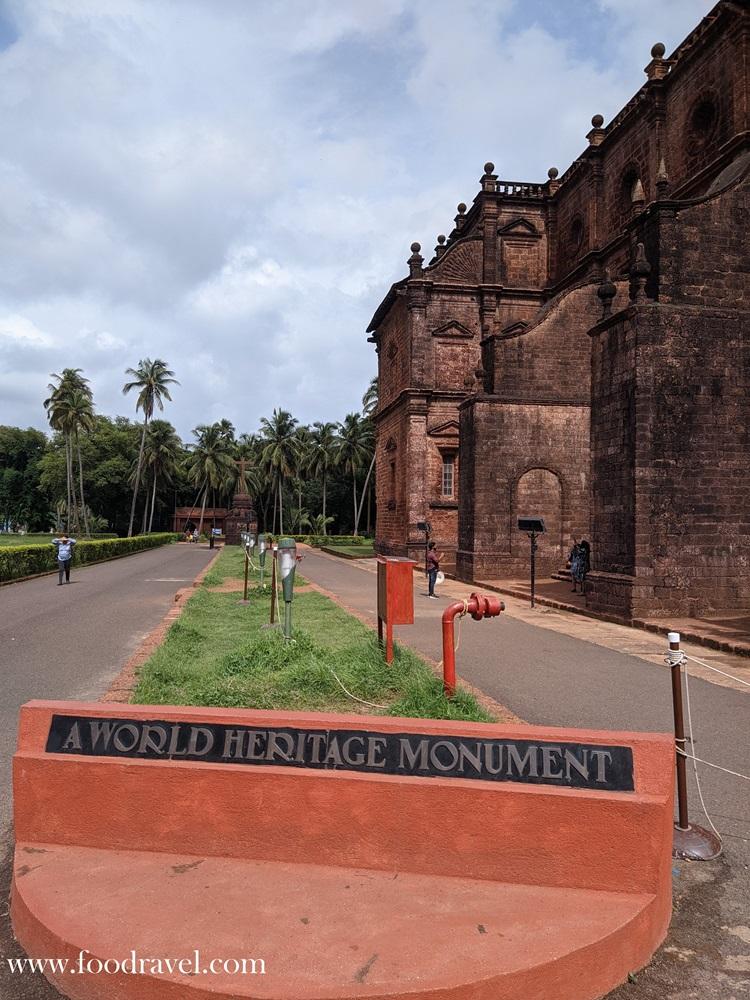As the sun cast its golden farewell over the Goan horizon, I wrapped up a bustling half day at work, and a thrilling adventure awaited me. With a swift and nimble scooty as my trusty steed, I embarked on a quest that had been beckoning me for far too long. The GPS screen displayed an enticing proximity to my humble abode, promising an evening of exploration and discovery in a corner of Goa’s rich history. Bom Jesus Basilica, a name that resonates with reverence and echoes with tales of centuries past, was the destination etched into my journey’s map. This magnificent basilica, bearing witness to the ebb and flow of time, tenderly cradled within its sacred walls a profound legacy of faith, culture, and artistry.
With the basilica’s closing hour marked at 6:30 PM, the fading daylight was my only limit. A fleeting pause of a couple of hours from the daily hustle became my passport to embark on this odyssey. This was no ordinary visit; it was an opportunity to immerse myself in a timeless masterpiece where every stone whispered a story, every arch echoed with devotion, and every corner held a piece of history’s tapestry. In the heart of Goa, I found not just a basilica but a rendezvous with a cherished past and an architectural wonder, a place where faith and history converged in captivating harmony. Join me as I unfold the enchanting narrative of my visit to Bom Jesus Basilica, where architecture transcends time.


Unearthing the Past:
Our voyage into the heart of Bom Jesus Basilica takes us on a compelling journey through time, where the sands of history have witnessed the rise of an architectural wonder, a beacon of faith. Construction work on this magnificent church commenced in the year 1594, and its story is intertwined with both determination and divine grace.
The Triumph of Consecration:
However, the journey towards completion was not without its trials, for it was a church not easily marked with a cross. It took over a decade of toil and devotion, and it was in May 1605 that the church was finally consecrated. The honor of this consecration belonged to the archbishop, Dom Fr. Aleixo de Menezes. This momentous occasion marked the birth of a world heritage monument and a landmark in the history of Christianity.
A Saint’s Resting Place:
What sets Bom Jesus Basilica apart from many other sacred places is the presence of the body of a beloved and revered figure, St. Francis Xavier. He was not only a devoted servant of the faith but also a close friend of St. Ignatius Loyola, with whom he founded the Society of Jesus, known as the Jesuits. However, the story of St. Francis Xavier’s earthly journey took a poignant turn when he passed away on Sancian Island, Chuandao, Taishan, while en route to continental China on 3 December 1552.
A Remarkable Return:
St. Francis Xavier’s earthly remains were first taken to Portuguese Malacca, and two years later, they were reverently shipped back to Goa. What sets his preservation apart is the extraordinary claim that the saint’s body remained as fresh as the day it was interred, a miraculous testament to his enduring sanctity. Today, the saint’s remains continue to attract a multitude of tourists from all corners of the world, transcending religious boundaries.
Miracles of Healing:
It is believed that the saint’s body possesses miraculous powers of healing, an awe-inspiring quality that adds another layer of reverence and wonder to this remarkable place of worship.
As we explore Bom Jesus Basilica, we not only uncover a sanctuary of faith but also a repository of history, where every stone bears witness to the enduring spirit of devotion and the remarkable events that have unfolded within these sacred walls.
Architectural Splendors of Bom Jesus Basilica: A Glimpse into Timeless Beauty
A Testament of Time:
The Basilica of Bom Jesus, proudly standing as one of the oldest churches in Goa and indeed in all of India, is a living testament to time’s embrace. Its architectural grandeur has endured for over four centuries, a remarkable feat that continues to captivate visitors from around the world.
Marble and Precious Stones:
Stepping into the basilica, one is immediately struck by the exquisite craftsmanship that adorns the interior. The floor, a masterpiece in itself, is a mosaic of marble inlaid with precious stones, showcasing the meticulous attention to detail. This opulent touch elevates the basilica to a realm of unparalleled beauty.
Simplicity and Elegance:
While the altars within the basilica are elaborate and gilded, the overall interior reflects a sense of simplicity. The focal point of the basilica is the main altar, which cradles a large statue of St. Ignatius of Loyola, the esteemed founder of the Society of Jesus, commonly known as the Jesuits. St. Ignatius, a dear companion of St. Francis Xavier, played a profound role in the saint’s spiritual journey. It was Ignatius who once asked Francis, “What does it profit a man, if he gains the whole world and loses his soul?” These words, etched in history, serve as a reminder of the profound spiritual connection between the two men.
The Gaze of Awe:
The gilded statue of Ignatius of Loyola, prominently displayed, gazes upward in awe at the name of Jesus (IHS) on the gilded emblem of the Jesuits, encircled by radiant rays. Above this emblem, we find the Holy Trinity, Father, Son, and Spirit, the ultimate source of inspiration and devotion for the faithful.
Altar of Significance:
The altar table used in Holy Mass is a resplendent work of art, gilded and adorned with figures of Christ and His apostles at the Last Supper. These figures accompany the sacred words, “Hi Mhoji Kudd,” meaning “This is my Body” in Konkani, a poignant reminder of the profound moment of consecration.
Painted Narratives:
The basilica also houses a collection of paintings that vividly depict scenes from the life of St. Francis Xavier. These works of art offer a visual journey into the life and legacy of the saint, enriching the visitor’s understanding of his remarkable story.
The Magnificent Mausoleum:
Above all else, the basilica’s most revered treasure is the mausoleum that cradles the silver casket containing the body of St. Francis Xavier. This mausoleum, a masterpiece in its own right, was designed by the 17th-century Florentine sculptor, Giovanni Battista Foggini. It took an impressive ten years to complete, a labor of devotion and artistry. The casket, fashioned from silver, encases the holy relics of the saint, and its radiance shines as brightly as the spirit it protects.
A Decennial Display:
The revered relics of St. Francis Xavier, a sight to behold, are displayed every ten years during the anniversary of the saint’s passing. This decennial exhibition is a rare and cherished opportunity for both Christian pilgrims and visitors from diverse backgrounds to witness the enduring sanctity of the saint.
The Basilica’s Art Gallery:
On the upper level, overlooking the tomb of St. Francis Xavier, lies the Bom Jesus Basilica Art Gallery. This gallery houses the works of the Goan surrealist painter, Dom Martin, offering a blend of modern artistic expression within the historical tapestry of the basilica.
Influential Connections:
It’s worth noting that the basilica’s historical significance has influenced a range of individuals, including author and fellow Jesuit, Anthony De Mello, who hailed from Goa and mentioned the basilica in his writings.
The Basilica of Bom Jesus, with its rich history, architectural grandeur, and spiritual significance, opens its doors to the public every day, inviting all to bask in the splendor of the past and witness the enduring legacy of faith and artistry. Within these hallowed walls, every visitor can experience a profound connection to history, devotion, and the enduring beauty of a bygone era.


The Bom Jesus Basilica is a harmonious blend of Baroque and Portuguese architectural styles, creating a visual masterpiece that stands as a testament to the architectural prowess of its time.
Baroque architecture, known for its exuberance and attention to detail, finds a splendid representation in the basilica’s design. The exterior façade, ornately adorned with intricate carvings and embellishments, draws the eye with its captivating beauty. Baroque elements exude a sense of drama and theatricality, inviting visitors to explore the depths of its artistry.
The Portuguese architectural influence is evident in the basilica’s structure and layout. The basilica’s architects carefully incorporated elements of Portuguese design, seamlessly integrating them with the grandeur of the Baroque style. This fusion results in a unique and awe-inspiring visual experience that pays homage to the rich cultural heritage of Goa.
Inside the basilica, the architectural grandeur continues to captivate. The wooden altars, finely carved with precision, stand as artistic treasures in themselves. The stained glass windows, resplendent with vibrant colors, filter the sunlight in a way that bathes the space in a surreal, otherworldly glow. These details, a testimony to the skill of the artisans, invite contemplation and admiration.
Delving deeper into the annals of history, we unearth a treasure trove of anecdotes and historical facts related to the basilica’s founding. This magnificent place of worship was conceived as a tribute to the revered figure, St. Francis Xavier. A luminary Jesuit missionary, St. Francis Xavier played a central role in Goa’s history, leaving an indelible mark on the region’s spiritual and cultural landscape. His earthly remains now rest within the basilica, encased in a silver casket, serving as a source of inspiration and reverence for countless pilgrims and visitors who seek solace and spiritual connection within these sacred walls.
Our exploration of Bom Jesus Basilica invites you to not only witness a remarkable architectural wonder but also to traverse through layers of history and faith. As we continue our journey, we will unravel more facets of this extraordinary basilica, where every stone tells a story, every sculpture breathes with devotion, and every visitor finds themselves transported to a time when artistry and faith converged in perfect harmony.

Bom Jesus Basilica: A Spiritual Pilgrimage and St. Francis Xavier’s Legacy
A Sanctuary of Spiritual Significance:
Bom Jesus Basilica is not merely an architectural masterpiece; it is a hallowed sanctuary of profound religious importance. This section embarks on a journey to unravel the spiritual significance that has made this basilica a revered icon in the hearts of the faithful.
A Pilgrimage of Devotion:
For centuries, Bom Jesus Basilica has been a magnet for pilgrims from across the globe. It stands as a symbol of devotion and faith, drawing individuals seeking a deeper connection to the divine and the spirit of St. Francis Xavier. Pilgrims arrive with hopes, dreams, and prayers, believing that their journey to this sacred site will bring them closer to the divine.
St. Francis Xavier’s Legacy:
At the heart of this religious significance lies the profound connection to St. Francis Xavier, a revered figure who dedicated his life to spreading the message of Christianity. The basilica is more than a final resting place for his earthly remains; it is a beacon of his legacy and an embodiment of his unwavering faith.
A Witness to Spiritual Events:
The walls of Bom Jesus Basilica have borne witness to a multitude of significant religious events and ceremonies. From solemn masses to processions and ceremonies of deep spiritual import, the basilica has been a stage for moments of profound faith. These stories of devotion echo through the centuries, weaving an intricate tapestry of spiritual significance.


Preservation and Restoration: A Call to Action
The Basilica of Bom Jesus, despite its historical significance and UNESCO World Heritage status, faces a pressing issue of structural deterioration. The roof of the basilica has a conspicuous hole, rendering it vulnerable to the annual monsoon rains. The Archaeological Survey of India (ASI), responsible for safeguarding this heritage structure, has been accused of neglect, prompting concern about the trustworthiness of the institution.
While the basilica is undoubtedly a historical artifact, it also functions as a “living religious heritage,” serving as a place of worship for the local community. Preservation efforts for such living monuments require a different approach, one that acknowledges the unique blend of history and contemporary use. Traditional conservation guidelines often fall short in addressing the needs of religious monuments still in active use. Local communities, deeply connected to these structures, express a willingness to participate in their preservation. The historical record reveals that the local community’s contributions, including labor and support, have been instrumental in the basilica’s longevity.
The Basilica of Bom Jesus, older than the iconic Taj Mahal, boasts a distinctive architectural façade and represents a cultural crossroads. Its construction in the late 16th century blended European aesthetics with locally sourced materials and labor. Despite the basilica’s historical roots, the restoration should not overlook the sentiments of the local population who have grown accustomed to its current appearance.
Restoring the basilica presents a multifaceted challenge. While the exposed laterite walls may have a certain aesthetic appeal, they are porous and susceptible to water absorption, leading to the structure’s deterioration. The local community’s attachment to the basilica’s current appearance, born from decades of exposure, complicates restoration efforts. Replastering and whitewashing the basilica would extend its life by addressing leaks and damage, but this decision requires consensus and careful consideration.
It is vital to recognize that while the ASI bears the responsibility of safeguarding the basilica, it’s an entirely different challenge when a heritage building remains a part of a living community. The ASI’s role as a custodian should extend to collaborating with local stakeholders. This not only respects the sentiments and traditions associated with the basilica but also leverages the knowledge and skills of artisans within the community.
The basilica’s ongoing preservation and restoration are paramount. The basilica’s spiritual significance and role as a cultural icon in Goa make it an enduring symbol of history and a testament to the resilient spirit of the local community. It calls for a concerted effort, a shared responsibility, to ensure its protection and longevity.


The Illuminating Light and Sound Show at Bom Jesus Basilica
For visitors to the hallowed grounds of Bom Jesus Basilica, there’s more to this historical site than just its awe-inspiring architecture and religious significance. Nestled amidst the ancient walls and towering facades of the basilica, an enlightening experience awaits those who seek to delve deeper into the life and journey of St. Francis Xavier.
The Basilica of Bom Jesus hosts a captivating light and sound show that brings to life the remarkable story of St. Francis Xavier. This multimedia spectacle offers a unique opportunity for both pilgrims and tourists to immerse themselves in the historical and spiritual narrative of this revered saint.
As the sun dips below the horizon and the stars start to twinkle in the Goan night sky, the basilica’s surroundings are bathed in an enchanting glow. Spectators gather in anticipation of the show, settling in for an evening of illumination and inspiration. With a humble ticket cost of just twenty rupees, this experience is accessible to all who wish to partake.
The show is a tribute to the life, work, and enduring legacy of St. Francis Xavier. Through the interplay of carefully choreographed lights and evocative soundscapes, the audience embarks on a journey through time. From his early days to his transformative encounter with St. Ignatius Loyola and the founding of the Society of Jesus (the Jesuits), the show encapsulates the pivotal moments that shaped the saint’s mission.
Through vivid imagery and emotive narration, the light and sound show transports viewers to the very places and times that witnessed St. Francis Xavier’s tireless efforts in spreading Christianity. It offers a glimpse into his travels, from Europe to Asia, and his unwavering commitment to the well-being of those he served.
The show concludes with a poignant reflection on the enduring presence of St. Francis Xavier in the hearts of the faithful. His relics, enshrined within the basilica, continue to draw pilgrims from around the world, a testament to the saint’s miraculous influence.
As the lights dim, and the final notes of the soundtrack resonate, spectators are left with a profound sense of connection to St. Francis Xavier’s extraordinary life. The light and sound show at Bom Jesus Basilica is not just a visual and auditory spectacle; it is a spiritual journey that touches the soul, reaffirming the basilica’s status as a living heritage and a beacon of faith.
So, if you find yourself in the vicinity of Old Goa and the venerable Bom Jesus Basilica, consider attending this mesmerizing show. For a mere twenty rupees, you can become part of an audience that witnesses the life journey of a saint whose impact still reverberates through time.

How to Reach Bom Jesus Basilica, Goa
Finding Your Way to this Sacred Destination
Visiting Bom Jesus Basilica in Old Goa is a journey to a place of deep historical and spiritual significance. To assist you in reaching this iconic destination, here are some helpful directions and transportation options:
By Air: The nearest airport to Bom Jesus Basilica is Dabolim Airport, which is approximately 25 kilometers away. From the airport, you can hire a taxi or take a pre-booked cab to reach the basilica. The drive offers scenic views of Goa’s lush landscape and picturesque villages.
By Train: If you prefer traveling by train, the Karmali Railway Station is the closest to the basilica. It’s located at a distance of about 10 kilometers. From the railway station, you can take a taxi or a local bus to reach your destination.
By Bus: Goa has an extensive bus network that connects different parts of the state. You can take a bus to the Kadamba Bus Terminal, which is approximately 9 kilometers away from the basilica. From there, you can avail a taxi or a local bus to reach your final destination.
Accommodations and Dining: For travelers planning to stay overnight, Old Goa offers a range of accommodations, from quaint guest houses to upscale hotels. These establishments provide a comfortable and convenient stay while you explore the area. Additionally, there are numerous dining options in Old Goa and nearby areas, where you can savor traditional Goan cuisine and international fare.
![]()


